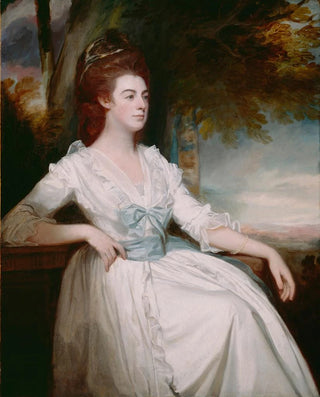Art print | Mademoiselle Clavering - George Romney


View from behind

Frame (optional)
George Romney's "Mademoiselle Clavering" is an iconic artwork that embodies the elegance and sophistication of the 18th century. This portrait, executed with remarkable finesse, captures not only the beauty of its subject but also the spirit of an era where art and fashion were closely intertwined. In this painting, the artist manages to transcend mere representation to offer a true immersion into the high society of his time. The delicacy of the features, the subtlety of the colors, and the expression on Mademoiselle Clavering's face all testify to Romney's skill in capturing the very essence of his subjects.
Style and uniqueness of the work
George Romney's style is distinguished by his ability to combine realism and idealization. In "Mademoiselle Clavering," he uses a palette of soft, harmonious colors that evoke both natural light and the richness of fabrics. The rendering of textures, especially of clothing and hair, demonstrates impressive technical mastery. The model's posture, slightly turned toward the viewer, invites subtle interaction, creating an intimate connection between the artwork and its observer. This painting does not merely depict a female figure; it also evokes a moment of grace, a pause amid the tumult of daily life, where one can appreciate the ephemeral beauty of the moment.
The artist and his influence
George Romney, born in 1734, is one of the most prominent portraitists of his era. His career was marked by encounters with emblematic figures of British society, which allowed him to develop a unique style that merges classicism with rococo influences. Romney established himself as a leading artist, attracting the attention of nobility and the upper bourgeoisie. His approach to portraiture goes beyond simple reproduction of physical traits; he seeks to reveal the personality and character of his subjects. This quest for psychological depth has had a lasting impact on how portraiture is perceived and created, inspiring many artists through the centuries.
An exceptional wall decoration signed Artem Legrand

Matte finish

View from behind

Frame (optional)
George Romney's "Mademoiselle Clavering" is an iconic artwork that embodies the elegance and sophistication of the 18th century. This portrait, executed with remarkable finesse, captures not only the beauty of its subject but also the spirit of an era where art and fashion were closely intertwined. In this painting, the artist manages to transcend mere representation to offer a true immersion into the high society of his time. The delicacy of the features, the subtlety of the colors, and the expression on Mademoiselle Clavering's face all testify to Romney's skill in capturing the very essence of his subjects.
Style and uniqueness of the work
George Romney's style is distinguished by his ability to combine realism and idealization. In "Mademoiselle Clavering," he uses a palette of soft, harmonious colors that evoke both natural light and the richness of fabrics. The rendering of textures, especially of clothing and hair, demonstrates impressive technical mastery. The model's posture, slightly turned toward the viewer, invites subtle interaction, creating an intimate connection between the artwork and its observer. This painting does not merely depict a female figure; it also evokes a moment of grace, a pause amid the tumult of daily life, where one can appreciate the ephemeral beauty of the moment.
The artist and his influence
George Romney, born in 1734, is one of the most prominent portraitists of his era. His career was marked by encounters with emblematic figures of British society, which allowed him to develop a unique style that merges classicism with rococo influences. Romney established himself as a leading artist, attracting the attention of nobility and the upper bourgeoisie. His approach to portraiture goes beyond simple reproduction of physical traits; he seeks to reveal the personality and character of his subjects. This quest for psychological depth has had a lasting impact on how portraiture is perceived and created, inspiring many artists through the centuries.
An exceptional wall decoration signed Artem Legrand






